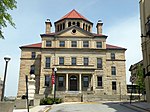F. Julius LeMoyne House
Historic house museums in PennsylvaniaHouses completed in 1812Houses in Washington County, PennsylvaniaHouses on the National Register of Historic Places in PennsylvaniaHouses on the Underground Railroad ... and 6 more
Museums in Washington County, PennsylvaniaNational Historic Landmarks in PennsylvaniaNational Register of Historic Places in Washington County, PennsylvaniaUnderground Railroad in PennsylvaniaUse mdy dates from August 2023Washington, Pennsylvania

The F. Julius LeMoyne House is a historic house museum at 49 East Maiden Street in Washington, Pennsylvania. Built in 1812, it was the home of Dr. Francis Julius LeMoyne (1798–1897), an antislavery activist who used it as a stop on the Underground Railroad. LeMoyne also assisted in the education of freed slaves after the American Civil War, founding the historically black LeMoyne–Owen College in Memphis, Tennessee. His house, now operated as a museum by the local historical society, was designated a National Historic Landmark in 1997. It is designated as a historic public landmark by the Washington County History & Landmarks Foundation.
Excerpt from the Wikipedia article F. Julius LeMoyne House (License: CC BY-SA 3.0, Authors, Images).F. Julius LeMoyne House
East Strawberry Avenue,
Geographical coordinates (GPS) Address Nearby Places Show on map
Geographical coordinates (GPS)
| Latitude | Longitude |
|---|---|
| N 40.168888888889 ° | E -80.243333333333 ° |
Address
East Strawberry Avenue
15301
Pennsylvania, United States
Open on Google Maps










